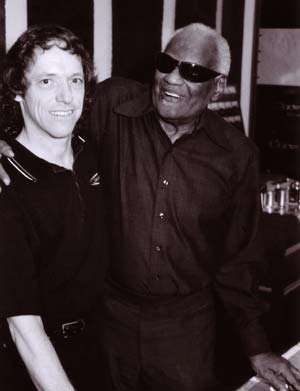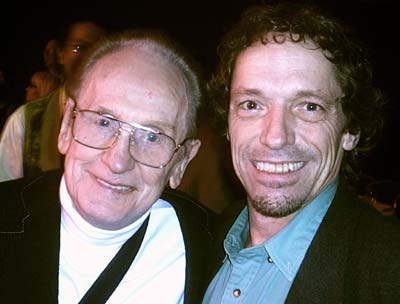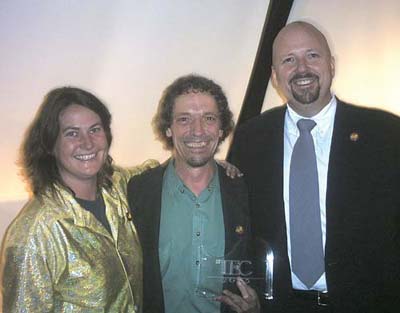Artist Interview: Terry Howard, Ray Charles' Longtime Engineer
By Marsha Vdovin
 |
|
Terrry Howard with the late Ray Charles
|
UA's company motto is "Analog Ears, Digital Minds." We want to give you the best of both worlds. I am so lucky to be able to interview so many seasoned and established engineers, as well as up-and-coming artists in this Webzine. Our readers seem to be really thirsty for history and techniques from the early and groundbreaking days of recording, and for those who specifically worked with Bill Putnam Sr. I recently had the pleasure of meeting Terry Howard recently in the AES show in New York City.
Let's talk about how you got started as an engineer.
It started when I was five years old. My great grandfather bought a Columbia tape recorder and he got into recording various family functions and things on the TV or radio. He brought this recorder home or over to my grandparents house. He recorded me, and I heard myself talking. Next thing I knew, I was making up songs and I'd ask my grandpa, "Grandpa, turn the tape recorder on. I want to sing." I still have some of those tapes that I did when I was five.
“Sometimes we would argue with people at the label who wanted the tempo speeded up, and you don't change Ray's decision on tempo-that's the emotion of the song.”
When I was seven, my mom noticed that I took an old shoe box and drew a tape recorder on it and made a pretend tape recorder. So for Christmas, they bought me a real cheap Sears tape recorder. It didn't have a capstan loader on it, so it played variable speeds as the tape went on through. When I was 11 years old, my mom bought me my first cassette recorder. When I was 13 I started working. I got into a local concert promoter, and my brother took me to a concert. As a matter of fact, the first concert I went to was a band called Jane's Gang before they got signed to ABC Records. But I went and heard them and befriended the concert promoter, and he would have me and my friends run around town putting up flyers in the stores promoting what concerts were in town. I got to get backstage. The next thing I knew, he had a reel-to-reel tape recorder that he gave me so I could record the bands when they played, because the bands always wanted to hear how they sounded at the concerts so that they could play better. They were all local bands.
In Cleveland?
Yeah, in the Cleveland area. So that got me involved in bands because I sat there next to the mixing console and live soundboard recording these bands, and I started getting into live sound. Then that progressed and, when I was seventeen, I started touring with some of the local bands that became regional acts. Then got to work with some other bands later on and did a little work with The Ramones, some earlier stuff with Heart.
Another thing, too, when I was nine I wanted to play guitar, so my dad took me to a friend of his and he gave me guitar lessons. Later on when I wanted to learn electronics, he took me to the same friend who was an electronic hobbyist; he built his own radios and that. He taught me how to built my first crystal radio, and then when I was twelve I built my first tube amplifier for a record player I had. That is how I started learning my electronics skills.
So when did you start working with Ray Charles?
After I got tired of that, I decided to move down to L.A. and further my career. I ran into another person who hooked me up with Tom Jones and I worked for his studio. I was working as a studio tech and got a job as a service tech for MCI. Ray bought an MCI 24-track, so they took me over there to install it. Mike Benau was very good friends with Ray and said, "This is our new service tech, Terry, and he is here to install your 24-track."
I can be a kidder, so when I turned on the tape recorder I said, "Wow, this thing didn't smoke like that at the shop." Ray grabs hold of the tape recorder and starts sniffing around it and he says, "I don't smell no smoke." I hadn't been introduced yet at the time. He says, "Who's messing with the blind man." Mike says, "That is our new tech, Terry. I said "Blind! I thought you just wore those glasses cause you were a musician."
Ray said, "I really like this guy. Terry. Put some skin in the pocket." That was his expression for shaking hands. He put his hand out. I shook his hand, and he pulled me in and gave me a hug. He leans over to Mike and says, "I like this guy; he is cool, don't let him go." That started the relationship with Ray and I. So I took care of his tape recorder, and one day he says to me, "T"-by then he'd nicknamed me T-"I don't want to pay them for your work; I want you to work for me. What do I have to do to get you to work for me?" I said, "Well, nine to five I work for the company; after five I can be yours." He said, "From now on, you come over here after five and work for me." So that started our relationship there.
 |
|
Les Paul with Terry at the TEC Awards
|
So in 1988 you started working full time with Ray and worked with him pretty much till he passed away?
Yes, in '88 we started archiving all his master recordings because he was one of the first artists to own all his own masters. He had me start going through those and he had me doing some reissues for Rhino records.
What is your experience with Universal Audio gear?
When I did live sound, we used to use their graphic EQs, their compressors and electronic crossovers. In my early studio experience, we used to use the speaker monitors. I've always had experience with Universal Audio, or at that time it was UREI. When I worked for the company where I was the MCI tech, Dean Austin called and asked for someone to help commission the rooms over at United Western. So me and my friend Robby went over and decommissioned the rooms. That was my first experience working directly with Universal, and occasionally Bill Putnam Sr. would come into the studio and I got to meet him a couple of times. Since I was also working with Ray, he would tell me a few of the Ray Charles stories from when he and Ray worked together. Just a short time after that, Bill Sr. passed away. It was great that I got the opportunity to meet him a few times, because when you do what I do in this business you really appreciate the technical people who make engineering easier.
Did you have a favorite signal chain for recording Ray's voice and Piano?
The microphones varied over the years with the type of songs. We used a Neumann 47, and later on we got a new one and we always used an LA-2A compressor.
Do you remember settings?
I always remember the dials as like the clock. The input dial was always at about eleven o'clock, and the gain reduction was over at two o'clock. I've always remembered dial settings like that. Ray, being blind, related the same way.
Have you had experience working with the re-issue hardware?
Oh yeah, when the reissued stuff came out, Ray and I immediately bought another LA-2A and two 1176s. Mainly because a lot of times the reissue stuff performed better than the old used stuff because as the things get used over the years (a lot of people love it, they say that it is a warmer sound), the tube changes and some of the resistance and some of the pads change a little bit too. When they came out, Ray and I immediately bought them because it was like buying the old stuff all over again.
When did you meet Bill Putnam Jr.?
At the first AES show he attended. I think it was about '98. He had the booth and I didn't know he had taken over the company, but when I saw his name tag, I went right over and said, "Bill Jr. I knew your dad. I work with Ray Charles, and Ray knew your dad very well." As a matter of fact, in the '60s, Ray was one of the first artists to own a 610 console. The one in Chicago was hand-built. Bill started making them for mass production and had sold two or three to other studios, and Ray was the first private artist to buy one of Bill's mixing boards.
What happened to that console?
I have some of the pieces of it. It was taken apart years and years ago. We had to clean out an old warehouse, and I have a few of the modules that were left behind and a couple of the power supplies.
Have you tried any of UA's digital products?
Yes. I have the UAD-1 and like it very much. I have, over the years, adjusted to the digital side. Ray and I fought for years and everyone thought we were fighting because we were old analog dogs, but the real reason was that nothing ever sounded good. It wasn't till the late '90s that there were vast improvements in the sound and Ray and I started using a lot of the software.
Tell me about your Grammys.
 |
|
EveAnna Manley and UA President Matt Ward celebrate with Terry at TEC Awards. Terry won for Creative Excellence on Record Production/Album: Genius Loves Company, Ray Charles.
|
It took a lot of energy for me, because after that, starting in about August, I was with Ray on a daily basis. Normally I would work with Ray about three or four days out of the week, three to six hours a day. At that point I was with him from the time he got to the studio at about eleven in the morning to the time he left at about six at night. He would be taking care of his health, and I would be in the control room going through songs and putting rough mixes together so I could play parts to him. Ray would choose a song and I would go sit down with him, and we would decide what arranger to use and what musicians to use. Ray and I would go over the song and decide what key the song would sound best in. This is something I would learn from Ray. There are two things that are very important things to do in a song. You don't set the key, because that is the key that the person can sing in. Each key has a different sound. If you go up and transpose, you'll notice that one key might sound more melodic than another one and one might sound sadder. He would say "Now which one sounds right for this song?" We would pick a step or two in either direction of the key the accompanying artist was singing in.
Ray taught me that tempo is very important. Sometimes we would sit there for an hour and then come in the next day and rethink it again and sit there with the metronome and count it off and play a part of the song and he would try out some vocal phrasing, and we would try different things till we felt that the emotion Ray wanted was coming through the music. Sometimes we would argue with people at the label who wanted the tempo speeded up, and you don't change Ray's decision on tempo-that's the emotion of the song.
The third thing I learned was timing. Ray said, "The drummer, the bass player, rhythm, they got to be in time." Once I was recording with him and he was a little late and I stopped him. He went off on me. "Now I'm going to tell you something Mr. T. You can tell the drum player, you can tell the bass player, you can tell the rhythm player that they're a little late, but I'm the star and what I'm doing is not timing, it's emotion. You don't mess with my emotion. And along with that, you never let the arrangement or the music outshine the star. The star should always be on top." And he would get mad at some of these mixes people do today where the vocalist is buried.
Another technique he had was that he typically sang a little bit flat. Almost everything he did. I noticed this in the era when everyone wanted to Auto-Tune everything. When I asked him about it, he said, "Yeah, that's an old trick. Because by me singing just a little bit flat, there ain't no way to bury me in the music. That's an old country trick. You listen to old country singers and they do that way; they never get buried, and the vocal always stays on top."